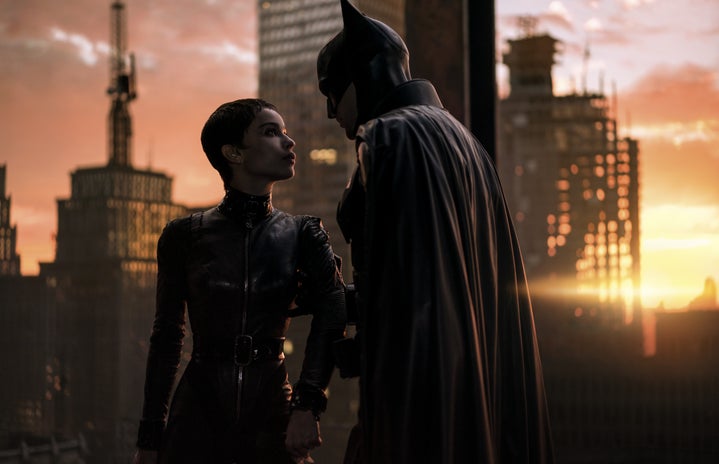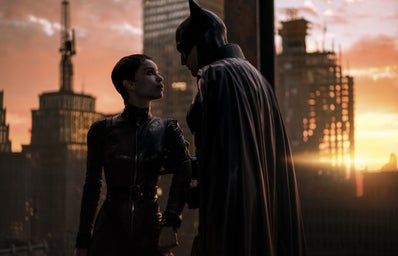Spoiler Warning: This article contains spoilers for The Batman, the most recent Batman film
I’m going to open this article with a weird, off-the-cuff statement: title notwithstanding, I’m not here to pit The Dark Knight and The Batman against each other. In fact, I’m going to do the opposite – propose that The Batman is both the spiritual successor to The Dark Knight and The Dark Knight’s inverse. Which, like, I get that might seem impossible, but it really is – and I can prove it, too.
One Tumblr user noted that the score for The Dark Knight is epic in sound – grandiose (as in the track I’m Not a Hero) blaring, directed to fill you with awe (as in A Dark Knight). Suffice to say, the score for the The Batman is far moodier, with lower strains and a sound that is at times soft and conciliatory (as in the track Funeral and Far Between) and at other times eerie and unsettling (as in The Riddler). And therein, I think, lies the difference between the two films.
The Dark Knight is an epic (by this I mean epic in the poetic sense – a long, intricate tale of two halves. Usually those of good and evil). The Batman is decidedly not epic. That is not to say that The Batman is bad by any measure – no, only that being “epic” is not at all one of the film’s aims.
So, let’s start with The Dark Knight. Ah yes, everyone’s ultimate Batman movie (allegedly). It’s the film that the Oscars notoriously denied (excepting Heath Ledger’s posthumous Oscar win). It’s Christopher Nolan’s magnum opus. To be sure, The Dark Knight is a brilliant movie. And in this argument, it’s an epic, too.
Early into The Dark Knight, Harvey Dent, the film’s white knight turned antihero, says, “You either die a hero or live long enough to see yourself become the villain.” The quote’s meaning is twofold: Dent, a crusading DA who’ll eventually turn into a killer by the film’s end, is tacitly referring to his own downfall. But there’s a second meaning here, one largely overlooked in favour of Dent’s downfall. Right before Dent makes this declaration, he and another character, Rachel, are arguing about the merits of self-sacrifice with regards to saving a city (Harvey: “When their enemies were at the gates, the Romans would suspend democracy and appoint one man to protect the city”). In response, Rachel raises the point that sometimes what appears to be self-sacrifice is just despotism (Rachel: “Harvey, the last person they appointed was named Caesar and he never gave up his power”). Not only do these two lines work as a clever lead up to Harvey’s iconic “die a villain” quote, but they also invoke the idea of the Roman Republic and its end. This in turn raises the possibility that in The Dark Knight, Gotham is akin to Rome. While Gotham is not quite an empire, by equating it to Rome it is given a sort of epic status. It becomes like Rome, like Troy in the Iliad (an epic poem): the ravaged city that must be saved by a hero. Naturally, The Dark Knight himself is the hero to do just that.
The Gotham of both The Dark Knight and The Batman is a city overwrought by corruption. The Dark Knight marries together this corruption (Batman fights the Mob early on and cripples the Mob by eventually freezing their funds) with another symbol. This second symbol is that of the villain or the arch-enemy, a theme that pops up in epics in various ways. In The Dark Knight, it takes the form of the Joker (who is ironically Batman’s most-well known enemy anyway). The Joker is decidedly an anti-Batman. Where Christian Bale’s Batman personifies order and hope in an otherwise lawless city (somewhat ironically given that he’s a vigilante), the Joker is an agent of pure chaos – he wants to tear the city in two both because he can and to prove that chaos is the only type of real order in this world. The Batman and the Joker are thus perfectly antithetical – two sides of a coin. Ironically, this coin metaphor is seized upon by The Dark Knight when the Joker’s machinations turn Harvey Dent into a literal two-face. Harvey also flips a coin to decide the fates of his victims – one side to die, one side to live. So, as in certain epics, a binary takes precedence. Here, the binary in question is that of good and evil. This binary is clearly the central theme of The Dark Knight, cementing its status as an epic film. Hell,even the Joker’s plan is epic in nature – it’s multilayered and complex, involving both an attempt to cripple Batman and erode the hero’s morality and to also prove that his worldview is correct by goading civilians into blowing each other up. So yes, The Dark Knight = Batman on the biggest scale, in terms of narrative and themes.
By contrast, The Batman is much smaller in scale. The two films do share themes though: Gotham is still a hellhole and corruption still is everywhere. In fact, The Batman’scentral mystery unravels to reveal a web of corruption that ensnares Gotham and implicates nearly all of its authority figures. And yet, despite these similarities, the staging of the two films is completely different. Where The Dark Knight painstakingly works to establish grandiose themes through its script and filmmaking style, the Batman often feels small scale despite its budget and the city-wide conflict that the film’s central mystery reveals.
But why does The Batman feel smaller or more intimate if it and The Dark Knight are similar?
Cut to the end of The Batman.
Near the film’s close, as Batman/Bruce Wayne rides away on his motorcycle, we get a close up of Robert Pattinson’s (aka Bruce Wayne) stern countenance glaring ahead of him. These close-ups (or medium close-ups) of Bruce looking morose or stern are pretty abundant in The Batman. Pattinson’s Bruce Wayne is a world away from Christian Bale’s slicker version in The Dark Knight. This Bruce is noticeably gaunt (in his face only though), speaks briefly and only to convey what he absolutely must, wears all-black and unironically wears black sunglasses indoors in the middle of winter.
This Bruce, well, he’s kind of emo, and he has none of the self-possession that Christian Bale’s Bruce had. Like, in the few scenes where Bruce is expected to appear as himself and not Batman, he’s laughably bad at being anything but sullen and intense. Even after Zoë Kravitz’s Catwoman/Selina Kyle has kissed him twice and made her feelings pretty clear, when they part ways Pattinson’s Batman (dubbed Battinson) can barely bring himself to incline his head towards Selina and you know, kiss her in return. The man is a walking mass of angst – but understandably so. Here, in The Batman, we get to see just how badly the murder of his parents has negatively impacted Bruce. He’s clearly struggling to process the trauma of the event, and that trauma has left him emotionally stunted. It’s this recognizable humanity that grounds Pattinson’s Batman and makes the film feel a lot more like a character study than The Dark Knight. Even Batman’s struggle with this film’s villain, The Riddler, plays out on a smaller scale, as we see Bruce actually working with Alfred to solve The Riddler’s ciphers and deploying Selina as a spy in a club to further unravel the Riddler’s masterplan. By contrast – in The Dark Knight Christian Bale’s Batman couldn’t even find the Joker without the aid of a digital imaging system. So, in a lot of ways, The Batman is truly The Dark Knight’s inverse – where the Dark Knight is epic, The Batman is small scale and intimate.
However, that being said, The Batman is also a twin of sorts to The Dark Knight. It’s no secret that The Dark Knight Rises is often considered a lacklustre sequel to The Dark Knight, and Batman V. Superman: Dawn of Justice was universally maligned. The Batman is the first Batman instalment following The Dark Knight to be widely praised by audiences and critics. In that way, it is something of a spiritual successor to the film, taking up the mantle of a well-thought-out Batman film for today’s audiences.
So, in total, it’s not about which film is better. Instead, The Batman and The Dark Knight are better looked at as filmic twins (well, inverted twins).
Rejoice, Batman fans: you’ve now got two brilliant properties to exalt!


